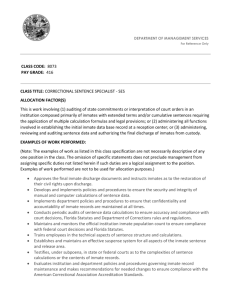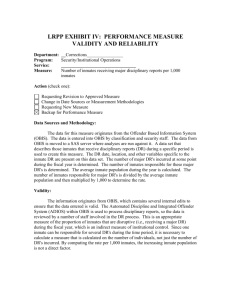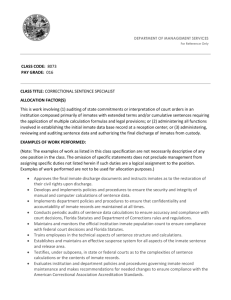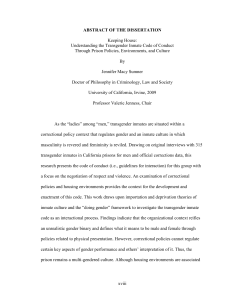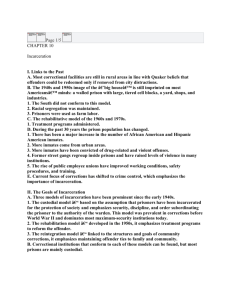Invisible Men: Mass Incarceration and the Myth of
advertisement
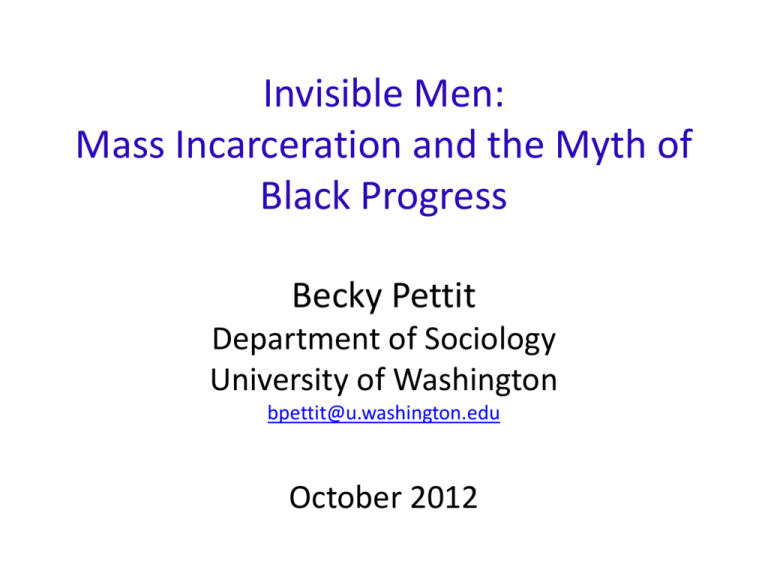
Invisible Men: Mass Incarceration and the Myth of Black Progress Becky Pettit Department of Sociology University of Washington bpettit@u.washington.edu October 2012 “I am invisible, understand, simply because people refuse to see me.” -Ralph Ellison, Invisible Man (1952) United States Prison and Jail Population, 1925-2008 Civilian Incarceration Rates, Men 20-34, by Education and Race LTHS HS/GED Some College All 1980 2.4 0.8 0.2 0.6 White Men 1990 2000 3.8 7.7 1.4 2.3 0.4 0.3 1.1 1.6 2008 12.0 2.0 0.3 1.8 Civilian Incarceration Rates, Men 20-34, by Education and Race LTHS HS/GED Some College All 1980 2.4 0.8 0.2 0.6 LTHS HS/GED Some College All 1980 10.6 4.7 1.9 5.2 White Men 1990 2000 3.8 7.7 1.4 2.3 0.4 0.3 1.1 1.6 Black Men 1990 2000 19.6 30.2 7.1 11.7 2.9 2.1 8.3 11.2 2008 12.0 2.0 0.3 1.8 2008 37.2 9.1 2.1 11.4 Educational Attainment of Male Inmates, 20-34 LTHS 1980 White Black 40.7 52.7 HS/GED 54.2 34.3 Some College 16.1 13.1 Educational Attainment of Male Inmates, 20-34 LTHS 1980 White Black 40.7 52.7 2008 White Black 52.7 61.8 HS/GED 54.2 34.3 35.5 30.6 Some College 16.1 13.1 11.8 7.7 Data Non-institutionalized population • Current Population Survey (CPS March 1980-2008) Data Non-institutionalized population • Current Population Survey (CPS March 1980-2008) Inmate population • Aggregate inmate counts (1980-2008) Data Non-institutionalized population • Current Population Survey (CPS March 1980-2008) Inmate population • Aggregate inmate counts (1980-2008) • Survey of Inmates of Local Jails (1978, 1983, 1989, 1996, 2002) • Survey of Inmates of State Correctional Facilities (1979, 1986, 1991, 1997, 2004) • Survey of Inmates of Federal Correctional Facilities (1991, 1997, 2004) Method • Construct estimates of indicators for household(HH) and inmate (I ) populations Method • Construct estimates of indicators for household(HH) and inmate (I ) populations • Calculate weighted average of indicators including both groups using weights derived from CPS estimates of the civilian population Percent of Men Not Completing High School/GED, 2008. Observed N-H White 7.2 N-H Black 13.5 Percent of Men Not Completing High School/GED, 2008. Observed Adjusted N-H White 7.2 8.0 N-H Black 13.5 19.0 Percent of Men Not Completing High School/GED, 2008. Observed Adjusted % Difference N-H White 7.2 8.0 11% N-H Black 13.5 19.0 41% Racial Inequality in High School Dropout Rates, Men 20-34, 1980-2008 “Selection Effect” due to Incarceration Conclusions • Prison or jail is normative among some social and demographic groups • Excluding inmates from surveys obscures portraits of inequality • Including inmates, we find: – No improvement in high school dropout rate among young, black men – Young, black, male dropouts are more likely to be in prison or jail than be employed – The same fraction of young, black male dropouts voted in 2008 as in 1980 Why is Invisible Men Challenging? • Out of the mainstream of American sociology, which now focuses on formulating and testing scientific hypotheses • Contradicts the notion of black progress in the post-civil rights era • Implicates much social science (and social scientists) as complicit
